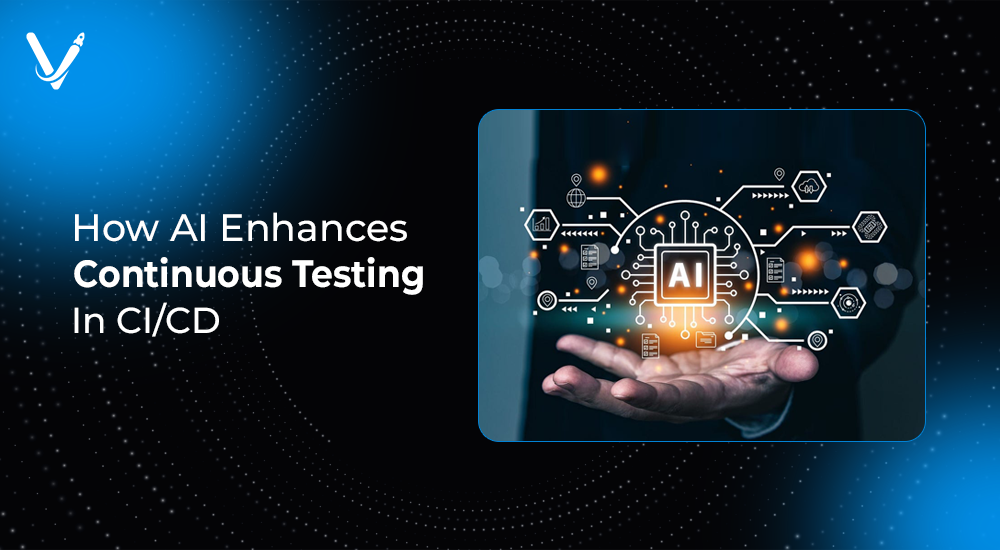How AI Enhances Continuous Testing in CI/CD


- Jun 19, 2025
Continuous integration and continuous delivery (CI/CD) have become the backbone of modern software development. In fast-paced DevOps environments, teams aim to release code updates frequently, reliably, and with minimal risk. At the heart of this process lies a critical practice—continuous testing. As software complexity and deployment velocity increase, traditional testing approaches often struggle to keep pace.
Enter Artificial Intelligence.
AI is redefining what’s possible in continuous testing by making it smarter, faster, and more adaptive. It helps identify bugs earlier, optimize test coverage, reduce false positives, and even predict failures before they happen. This article dives deep into how AI is enhancing continuous testing in CI/CD pipelines, supported by real-world examples, emerging tools, best practices, and actionable strategies to stay ahead.
Continuous testing is the practice of executing automated tests at every stage of the CI/CD pipeline. It ensures that software changes are validated early and often, minimizing the risk of defects slipping into production.
Key benefits of continuous testing:
However, without AI, continuous testing can become a bottleneck. Manual test case generation, flakiness in automation scripts, and redundant test execution can slow down the entire pipeline. AI brings a solution by introducing intelligence into the testing lifecycle.
AI introduces autonomy, adaptability, and predictive capabilities to continuous testing. Instead of relying solely on scripted logic, AI systems can learn from patterns, analyze outcomes, and recommend optimizations.
How AI transforms testing workflows:
By integrating AI into testing pipelines, organizations can shorten feedback loops, reduce costs, and achieve higher test reliability.
Before exploring AI-powered testing, it’s essential to understand the limitations of traditional methods in high-speed DevOps environments.
Common challenges:
These issues impact team productivity and slow down innovation. AI addresses each of these problems with a data-driven and learning-based approach.
Let’s break down how AI adds value at each stage of the testing lifecycle—from test creation to execution, analysis, and optimization.
Creating test cases manually is time-consuming and error-prone. AI can analyze historical data, user interactions, and application flows to automatically generate effective test cases.
Example:
AI-based tools like Testim and Functionize use natural language processing (NLP) and visual modeling to create functional tests without needing code.
Benefits:
Running every test on every build is inefficient. AI helps prioritize test cases based on risk, code changes, and historical failure patterns.
Use case:
Facebook uses AI to predict which tests are most likely to fail based on past code check-ins and runs only those during pre-merge validations.
Outcome:
Flaky tests—tests that sometimes pass and sometimes fail without code changes—are one of the biggest challenges in CI pipelines.
AI solution:
AI models analyze test logs, execution history, and environmental factors to flag flaky tests and isolate them for review.
Tools like:
Launchable, TestFlix, and Google’s internal tooling help teams reduce noise from non-deterministic tests.
When application UIs change frequently, maintaining test scripts becomes tedious. AI tools detect changes and auto-heal broken selectors or test steps.
Example:
mabl and Tricentis Tosca auto-update scripts when UI changes are detected using visual AI and DOM intelligence.
Result:
AI can generate synthetic, production-like data for test environments, eliminating privacy risks and improving test realism.
Benefits:
Several tools now offer AI-driven features that elevate continuous testing capabilities. Here's a look at a few standout platforms:
Testim:
Uses machine learning for stable UI tests and self-healing functionality.
Mabl:
Combines AI with low-code interfaces to deliver intelligent browser tests and automated visual validations.
Functionize:
Applies NLP and ML to create scalable, resilient end-to-end tests with minimal human input.
Applitools Eyes:
Visual AI platform that detects layout or UI anomalies with pixel-level accuracy.
TestCraft:
Codeless Selenium-based platform that leverages AI for faster test creation and maintenance.
These tools showcase how AI can seamlessly integrate into CI/CD ecosystems to boost automation and reliability.
Microsoft integrated machine learning into Azure DevOps to optimize its testing strategy. Using historical test data, the system predicts which tests are most relevant to a specific change and prioritizes their execution. This approach helped reduce test execution time by over 30% across large enterprise pipelines.
Netflix employs AI models to monitor microservices and predict failures based on infrastructure metrics. Combined with tools like Chaos Monkey, they continuously test for resilience and automatically fix or roll back failing services.
Capital One uses visual AI tools to automate regression testing for its customer-facing apps. This ensures that frequent UI changes don’t degrade user experience—a critical aspect for a digital-first financial enterprise.
Shift-left testing involves validating code earlier in the development cycle. AI helps by:
Shift-right testing focuses on validating apps in production. AI enhances this by:
The result is a continuous learning loop where AI assists both development and operations in delivering quality software at speed.
Transitioning to AI-driven testing doesn’t happen overnight. Here are steps to get started:
Start Small, Scale Fast
Begin by integrating AI features into your existing testing tools or processes. Prioritize high-impact areas like flaky test detection or visual regression.
Identify Bottlenecks
Use CI/CD analytics to spot areas with high test failures, slow execution times, or maintenance burdens—ideal candidates for AI optimization.
Train Teams on AI Tools
Invest in upskilling QA and DevOps teams to effectively use AI-enhanced platforms and interpret ML-generated insights.
Measure ROI
Track metrics like test coverage, execution time, and bug detection rate to quantify the benefits of AI integration.
Ensure Ethical AI Use
Use transparent AI models and ensure compliance with data privacy standards during test data handling or model training.
As AI continues to mature, the future of continuous testing looks autonomous, predictive, and fully integrated with DevOps ecosystems.
Emerging trends to watch:
This evolution will free up human testers to focus on exploratory, creative, and high-value testing tasks.
AI is not replacing testers—it’s empowering them. By integrating machine learning and data-driven intelligence into continuous testing workflows, organizations can increase test accuracy, speed, and coverage without compromising quality.
In today’s fast-paced CI/CD environments, teams that embrace AI stand to deliver better software, faster and with greater confidence.
At Vasundhara Infotech, we help forward-thinking companies implement intelligent test automation strategies that scale. Ready to level up your DevOps with AI-powered continuous testing? Let’s build the future of smart software together. Contact us today.
Copyright © 2025 Vasundhara Infotech. All Rights Reserved.
